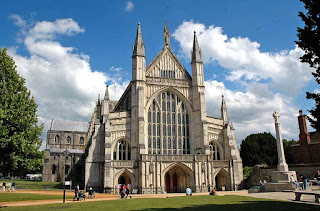The cathedrals of Britain span the millennium - from the cathedrals dating from the 1100s to the modern cathedrals found in Liverpool and Coventry. They display a wide array of architectural styles from Early English Gothic, to the majesty of the Renaissance at St Paul's and the sixties modernism of Liverpool's Roman Catholic Cathedral. In the Middle Ages and up to the Reformation in the 1500s, the Church enjoyed enormous power and wealth, and cathedrals are eloquent symbols of its dominant place in British society.
Cathedrals were elaborate and brightly colored before much of the interior decoration and original medieval art was destroyed during the Reformation and the Civil War. During the Civil War, cathedrals were used as garrisons, prisons and even stables. Now only traces remain of the vibrant colors that were often whitewashed out of existence.Many of the cathedrals in Britain are orientated east to west. The nave is situated in the west end of the cathedral where people would come to pray. For that reason, it is the long hall of the cathedral.
Winchester Cathedral stands on a site that has been a place of Christian worship for over a thousand years. In the 1000s, the old Minster was destroyed to make way for the new cathedral. This is one of the largest medieval churches in the world thanks to a nave of over 160 metres long and provides a fitting home for the Bishops of Winchester, some of whom weren't just the wealthiest men in England but in Europe as well. The Bishops' power and affluence is indicated by the many grand memorial chapels in the cathedral which house their tombs. Among these luminaries are Stephen Gardiner who officiated at the wedding between Mary Tudor and Phillip of Spain in 1554 and Henry Beaufort, half brother to Henry IV and banker to Henry V.For centuries, Winchester was a place of pilgrimage. It was the last resting place of Saint Swithun who lived in the 9th century. After his death, his bones were said to heal the sick and pilgrims flocked to the cathedral in their thousands. Stalls were set up to sell relics and clay models of the parts of the body that required healing. These were then placed in the shrine in the hope of a miracle cure.Winchester Cathedral boasts some of the finest medieval wood carving in Britain, if not Europe. In the 13th century England's greatest carpenter, William Lyngewode, spent four years decorating the cathedral's stalls. Another outstanding example of its medieval art is the Great Screen. It was erected in the 1400s but the original statues with their vivid colours didn't survive England's religious upheavals. Now, only the whitewashed backdrop of the original screen remains while the current statues are Victorian.Events have taken their toll on the cathedral. The West Window was smashed by the Roundheads during the English Civil War in the 1600s. The locals pieced it together but in it has the appearance of a rather abstract art work. The cathedral is also home to the beautifully decorated Winchester Bible, the best example of a 12th century bible in the country. Winchester Cathedral's power and influence came to an end with the Reformation in the 1500s and the Dissolution of the Monasteries during Henry VIII's reign. The scale of the Church's power can be imagined when it is considered that it controlled one third of the country's wealth before Henry VIII stripped it of much of its lands and privileges.
Sources-(http://www.timeref.com/places/hpl636.htm)
(http://www.travelwessex.com/History-of-Winchester-Cathedral.html)




No comments:
Post a Comment